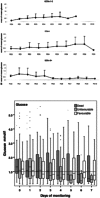Glucose metabolism following human traumatic brain injury: methods of assessment and pathophysiological findings
- PMID: 25413449
- PMCID: PMC4555200
- DOI: 10.1007/s11011-014-9628-y
Glucose metabolism following human traumatic brain injury: methods of assessment and pathophysiological findings
Abstract
The pathophysiology of traumatic brain (TBI) injury involves changes to glucose uptake into the brain and its subsequent metabolism. We review the methods used to study cerebral glucose metabolism with a focus on those used in clinical TBI studies. Arterio-venous measurements provide a global measure of glucose uptake into the brain. Microdialysis allows the in vivo sampling of brain extracellular fluid and is well suited to the longitudinal assessment of metabolism after TBI in the clinical setting. A recent novel development is the use of microdialysis to deliver glucose and other energy substrates labelled with carbon-13, which allows the metabolism of glucose and other substrates to be tracked. Positron emission tomography and magnetic resonance spectroscopy allow regional differences in metabolism to be assessed. We summarise the data published from these techniques and review their potential uses in the clinical setting.
Figures






Similar articles
-
A combined microdialysis and FDG-PET study of glucose metabolism in head injury.Acta Neurochir (Wien). 2009 Jan;151(1):51-61; discussion 61. doi: 10.1007/s00701-008-0169-1. Epub 2008 Dec 20. Acta Neurochir (Wien). 2009. PMID: 19099177
-
Glucose metabolism in traumatic brain injury: a combined microdialysis and [18F]-2-fluoro-2-deoxy-D-glucose-positron emission tomography (FDG-PET) study.Acta Neurochir Suppl. 2005;95:165-8. doi: 10.1007/3-211-32318-x_35. Acta Neurochir Suppl. 2005. PMID: 16463843 Clinical Trial.
-
Cerebral glucose metabolism after traumatic brain injury in the rat studied by 13C-glucose and microdialysis.Acta Neurochir (Wien). 2011 Mar;153(3):653-8. doi: 10.1007/s00701-010-0871-7. Epub 2010 Nov 21. Acta Neurochir (Wien). 2011. PMID: 21103896
-
Continuous monitoring of cerebral metabolism in traumatic brain injury: a focus on cerebral microdialysis.Curr Opin Crit Care. 2006 Apr;12(2):112-8. doi: 10.1097/01.ccx.0000216576.11439.df. Curr Opin Crit Care. 2006. PMID: 16543785 Review.
-
(13)C-labelled microdialysis studies of cerebral metabolism in TBI patients.Eur J Pharm Sci. 2014 Jun 16;57(100):87-97. doi: 10.1016/j.ejps.2013.12.012. Epub 2013 Dec 20. Eur J Pharm Sci. 2014. PMID: 24361470 Free PMC article. Review.
Cited by
-
Early Post-ischemic Brain Glucose Metabolism Is Dependent on Function of TLR2: a Study Using [18F]F-FDG PET-CT in a Mouse Model of Cardiac Arrest and Cardiopulmonary Resuscitation.Mol Imaging Biol. 2022 Jun;24(3):466-478. doi: 10.1007/s11307-021-01677-y. Epub 2021 Nov 15. Mol Imaging Biol. 2022. PMID: 34779968 Free PMC article.
-
Tracing the path of disruption: 13C isotope applications in traumatic brain injury-induced metabolic dysfunction.CNS Neurosci Ther. 2024 Mar;30(3):e14693. doi: 10.1111/cns.14693. CNS Neurosci Ther. 2024. PMID: 38544365 Free PMC article. Review.
-
Metabolic reprogramming mediates hippocampal microglial M1 polarization in response to surgical trauma causing perioperative neurocognitive disorders.J Neuroinflammation. 2021 Nov 13;18(1):267. doi: 10.1186/s12974-021-02318-5. J Neuroinflammation. 2021. PMID: 34774071 Free PMC article.
-
Nutrition Therapy, Glucose Control, and Brain Metabolism in Traumatic Brain Injury: A Multimodal Monitoring Approach.Front Neurosci. 2020 Mar 24;14:190. doi: 10.3389/fnins.2020.00190. eCollection 2020. Front Neurosci. 2020. PMID: 32265626 Free PMC article. Review.
-
Metabolic imaging of energy metabolism in traumatic brain injury using hyperpolarized [1-13C]pyruvate.Sci Rep. 2017 May 15;7(1):1907. doi: 10.1038/s41598-017-01736-x. Sci Rep. 2017. PMID: 28507314 Free PMC article.
References
Publication types
MeSH terms
Substances
Grants and funding
LinkOut - more resources
Full Text Sources
Other Literature Sources

